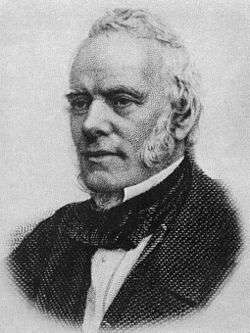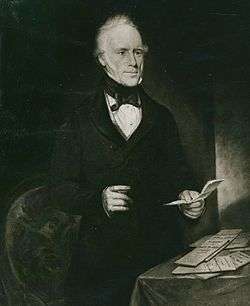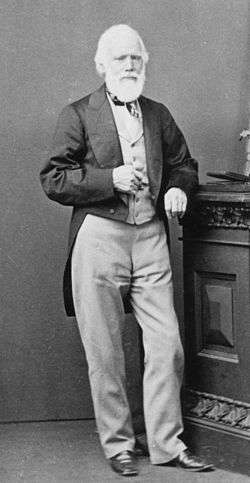George Fife Angas



George Fife Angas (1 May 1789 – 15 May 1879) was an English businessman and banker who, from England, played a significant part in the formation and establishment of the Colony of South Australia. He established the South Australian Company and was its founding chairman of the board of directors. In later life he migrated to the colony and served as a member of the first South Australian Legislative Council.
Early life
Angas was born at Newcastle upon Tyne, England, fifth son of Caleb Angas of Newcastle (1743–1831) and his second wife Sarah Angas née Lindsay (1749–1802). Caleb was a successful coach builder and ship owner. After his mother's death, he continued his education at a boarding school and at age 15 became an apprentice coachbuilder under his father's direction. Four years later he went to London to gain further experience and returned to Newcastle in 1809 where he worked as a supervisor for his father's business. On 12 April 1812 in Hutton, Essex, he married Rosetta French(1793–1867), daughter of John French (1761–1829), "Gentleman of Hutton, Essex", and Rosetta French née Rayner (1756–1836). They had three sons and four daughters.
Career
Over the next 20 years Angas took a large role in the family business in Newcastle with branches in British ports, the West Indies and Spanish America, and steadily developed his own shipping business in London, also spending time in Honduras. Angas came from a religious household, and as a religious person became a secretary of the Newcastle Sunday School Union. He was asked to stand for Parliament on two occasions but declined partly due to reasons of poor health. He had a talent for banking, and played a large part in the founding of the National Provincial Bank of England (in 1833, which exists today after several mergers as NatWest), sitting as a director on its first board, the Union Bank of Australia (in 1836) and the South Australian Banking Company (in 1840).
Angas had become relatively wealthy and was concerned with putting his money to the best use. He became interested in a proposed settlement in South Australia and in 1832 joined the committee of the South Australian Land Company. His own views on systematic colonisation dealt with the exclusion of convicts, concentration of settlers, sending out (preferably religious) intelligent people with capital, the emigration of young couples of good character, free trade, free government, and freedom of religion.
Angas was discouraged by the company's failure to get government support, but continued his involvement with the South Australian Association which was formed in 1834, with Robert Gouger as secretary. During debates on the price of land Angas, who held the opposite view to Edward Gibbon Wakefield, wanted the price of land to be low. However, the Colonization Commission set a high price for land which brought sales of land, and hence establishment of the colony, to a standstill. Angas formed a joint-stock company to buy the remaining land, which was transferred in January 1836 to the newly formed South Australian Company. In February 1836, the first of three ships set sail for South Australia with emigrants, livestock and provisions on board. The company supervisors were provided with minutely detailed instructions covering almost any problem which might have arisen. All three ships arrived by the middle of August.
The colonial office, the board of commissioners, and the South Australian Company would determine the success or failure of the colony and it was still unclear which was the controlling body. There was initial friction between the company and the commissioners. The establishment a banking business in 1837, and its separation as the South Australian Banking Company in 1840, at the behest of Angas, played an important part in the early growth of the colony. Angas worked on behalf of the bank in England giving lectures, writing pamphlets and supplying information to newspapers. He also helped to establish the South Australian School Society, and sent out missionaries and German colonists. He set up the Union Bank of Australia in England and also found the time to be active in the colonisation of New Zealand. In recognition of his efforts in making New Zealand an English colony rather than a French colony, Angas was offered a knighthood and a then baronetcy, but he declined both.
George Fife Angas was also a leading figure in attempting to establish and secure proper treatment of the Aborigines of South Australia. "Mr Angas set before himself the model of William Penn and his treaty with the North American Indians for establishing friendly and equitable relations with the Europeans." (Hodder) Using his position as Commissioner, he attempted to secure Aborigine rights in both legislature and through financing missionary actions.
In 1836, Angas met with Pastor August Kavel, who was Pastor in Klępsk (Klemzig) in Prussia. Kavel and his Lutheran congregation at Klemzig faced oppression due to decrees made by King Frederick William III. They sought to regain their religious freedom by emigrating to another country. Angas sent his chief clerk, Charles Flaxman to Prussia to meet with Kavel's group. Flaxman on returning, gave a favorable report to Angas, who then sought to have the South Australian Company meet the cost of the transport for the whole congregation from Hamburg to South Australia. This request was declined, and so Angas made a loan to this group of emigrants, by meeting the cost of securing vessels himself. In 1838 Angas chartered four ships on their behalf; Prince George, Bengalee, Zebra, and Catharina. This loan, along with another Angas had made to his chief clerk Charles Flaxman, (who invested in land in South Australia), put Angas in a difficult financial situation the next year. Angas had borrowed heavily and was forced to sell his interests in the Union Bank and other companies.
News came that the British government had dishonoured drafts drawn by the Governor, George Gawler and that the colony was in danger of ruin. Angas appealed to the government, his efforts resulting in a loan to the colony and payment of the dishonoured drafts.
In 1842 Angas lectured extensively on South Australia and wrote a pamphlet, "Facts Illustrative of South Australia", which was widely distributed. Gawler, who had been recalled to England, suggested that Angas should settle in South Australia. In early 1843, his finances still troubled, he sent out his 19-year-old son John Howard Angas to supervise his land and recover the family fortunes. Angas was unable to sell his northern England properties until 1850 but some repayments had come in from the German settlers. The stress had affected his health and he decided to migrate to Australia, arriving in Adelaide with his wife and youngest son in January 1851.
Late life
Angas, by then almost 62, was met by his two sons and eldest daughter. His work on behalf of the colony were widely known and a few days later a public dinner was held in his honour. He found work, becoming elected as a member of the Legislative Council for the Barossa district and turned his attention towards education and other public interests. Being kept busy improved his health, and he was able to pay off his debts in short order.
Angas bought Merino sheep and cattle, employing out-of work migrants on his property. He returned to England from 1857 to September 1859 to settle matters in his father's estate. He continued parliamentary work and lobbied against South Australia being given responsibility for the administration of the Northern Territory. He resigned in 1866 feeling that he could not fully fulfil his role, and continued to contribute to schools, churches and charities. His wife of 55 years died in 1867. In 1869 he published a History of the Newcastle upon Tyne Sunday School Union which was compiled with the help of secretary W. R. Lawson. Although retired from parliamentary duties, managing his property at Angaston gave him plenty to do. He recovered from a serious illness at 87 and died on 15 May 1879 at 90 years of age. He was survived by three sons, notably John Howard Angas and George French Angas, and three daughters.
References
- Serle, Percival (1949). "Angas, George Fife". Dictionary of Australian Biography. Sydney: Angus and Robertson.
- 'Angas, George Fife (1789–1879)', Australian Dictionary of Biography, Volume 1, Melbourne University Press, 1966, pp 15–18. accessed 2008-01-15
- "The Confessional Lutheran Emigrations From Prussia And Saxony Around 1839", Westerhaus, Martin O.
- George Fife Angas, Father and Founder of South Australia, Edwin Hodder, Hodder and Stoughton, London MDCCCXCI
Publications
Summary: The album contains press cuttings concerning the Angas family, including obituaries of George Fife Angas, George French Angas and Henry Willmott, the laying of the foundation stone of the Bushmen's Club (1878) and the first and second reports of the South Australia Company (1836 and 1838).
See also
- History of Adelaide
- Mennell, Philip (1892). "
 Angas, George Fife". The Dictionary of Australasian Biography. London: Hutchinson & Co. Wikisource
Angas, George Fife". The Dictionary of Australasian Biography. London: Hutchinson & Co. Wikisource